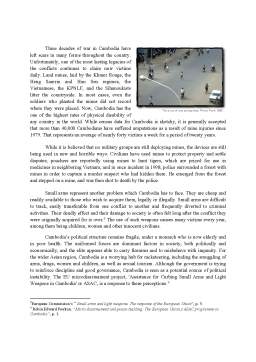Extras din referat
The Cold War, in which super-powers sought to maintain a global balance of power without resorting to nuclear arms, masked many local, intra-state conflicts by internationalizing them. What in actuality were civil wars among indigenes contending for local power were turned into “virtual” international conflicts fought by proxy. With the end of the Cold War, the virtual bubble burst, leaving an unprecedented number of civil wars. Consequently, peace-keeping and peace-building have taken on new prominence as tasks for the United Nations. In the first 45 years of its existence, the UN spent 23% of its budget, or about 3.6 billion US dollars, on peace-keeping. And the number has been increasing since then. Such operations happened in countries like Cambodia, Rwanda, Guatemala, Somalia, Albania and many more. I will discuss further only the case of Cambodia.
A peek in the history of “the Gentle Land ”
Cambodia’s situation can be attributed to numerous different factors throughout the country’s history. Although Cambodia had a rich and powerful past under the Hindu state of Funan and the Kingdom of Angkor, by the mid-19th century the country was on the verge of dissolution. After repeated requests for French assistance, a protectorate was established in 1863. By 1884, Cambodia was a virtual colony; soon after it was made part of the Indochina Union with Annam, Tonkin, Cochin-China, and Laos. France continued to control the country even after the start of World War II through its Vichy government. In 1945, the Japanese dissolved the colonial administration, and King Norodom Sihanouk declared an independent, anti-colonial government under Prime Minister Son Ngoc Thanh in March 1945. The Allies deposed this government in October. In January 1953, Sihanouk named his father as regent and went into self-imposed exile, refusing to return until Cambodia gained genuine independence.
Sihanouk's actions hastened the French Government's July 4, 1953 announcement of its readiness to grant independence, which came on November 9, 1953. The situation remained uncertain until a 1954 conference was held in Geneva to settle the French-Indochina war. All participants, except the United States and the State of Vietnam, associated themselves (by voice) with the final declaration. The Cambodian delegation agreed to the neutrality of the three Indochinese states but insisted on a provision in the cease-fire agreement that left the Cambodian Government free to call for outside military assistance should the Viet Minh or others threaten its territory.
Although Cambodia finally gained its independence, the need for a new government led to the rise of Communism, and ultimately the rise of Pol Pot. When Pol Pot officially took power in 1975, he began a four-year torture and killing rampage, killing nearly two million people and affecting the lives of millions more. The Khmer Rouge regime caused destruction, violence, torture and death, concluding that more than 1,200,000 men, women and children died as a consequence of the actions taken by the Communists after they assumed power in April, 1975. Cambodia today is a land without universities, without cities, commerce, art, music, literature, science or hope. And, as one young refugee said, "There is no love anywhere."
One of the strategies of the Khmer Rouge was to disarm the entire population, so that the civilians became too weak and powerless to raise any threats. Soldiers were dispatched to the countryside, in order to start the disarmament. "We are here now to protect you, and no one has a need for a weapon any more," one survivor of the Cambodian holocaust recalled in the January 24, 1994 issue of The New Yorker. The account described how "everyone who had a weapon handed over [their] rifles and pistols and ammunition, which the soldiers tossed on a pile" and disposed of. In short order the rulers of what R.J. Rummel calls the "Cambodian Hell State" were stacking skulls in piles as they slaughtered one-third of the disarmed population.
The need for a change
After thirty years of civil war and fifty years of war along the Vietnam-Cambodia frontier provoked by external forces, Cambodia finds itself in a state of precarious peace. The countryside is flooded with weapons of every description. The last serious fighting was stilled only in 1998, when the royalist Funcipec party (led by Prince Norodom Ranaridh, a son of King
Bibliografie
- Geofrey Mugumya. “Exchanging Weapons for Development in Cambodia. An Assessment of Different Weapon Collection Strategies by Local People”, United Nations Publications, 2005.
- Nat J. Colleta, Michelle L. Cullen. “Violent conflict and the transformation of social capital. Lesson from Cambodia, Rwanda, Guatemala, and Somalia”, The World Bank, Washington D.C., 2000.
- Breanna Atwood. “Khmer Rouge: Evolution of the Academic Debate”- A Senior Project for the Faculty of the History Department, California, 2010.
- Robin Edward Poulton. “Micro-disarmament and peace-building: The European Union’s ASAC programme in Cambodia”, 2001.
- European Commission’s “ Small arms and light weapons. The response of the European Union”, 2001.
- Kuniko Inoguchi. “Discussion Paper on Disarmament and Human Security” in the 41st Session of the UN Secretary-General’s Advisory Board on Disarmament Matters 16-18 July 2003, Geneva, Switzerland.
- Law on the Management of Weapons, Explosives and Ammunition, 2005.
- Statement by H.E. Dr. Kosal Sea, Ambassador, Permanent Representative of the Kingdom of Cambodia to the United Nations, at the General Debate of the First Committee of 64th Session of the UN General Assembly, New York, 8 October 2009.
- http://www.state.gov/r/pa/ei/bgn/2732.htm
- http://www.foreignaffairs.com/articles/31487/donald-s-zagoria/murder-of-a-gentle-land
- http://www.reformed-theology.org/html/issue11/bonfire_of_the_liberties.htm
Preview document
Conținut arhivă zip
- The issue of disarmament in Cambodia.doc















